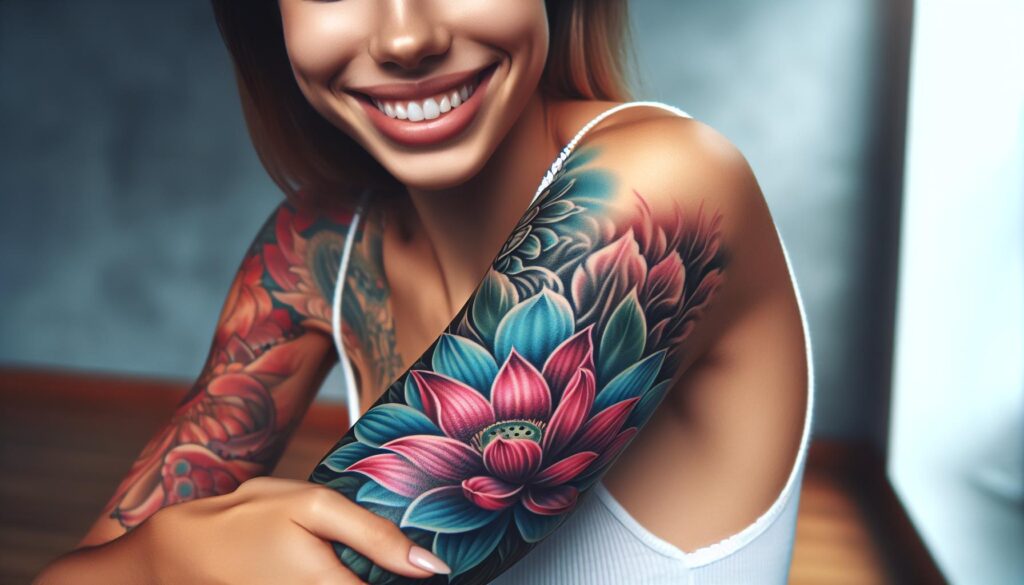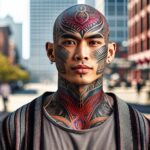Korean tattoo symbols carry deep meanings and a rich cultural heritage. We explore the significance behind each design, helping you choose a symbol that truly represents your story.
From the elegance of traditional characters to modern interpretations, our guide unveils the beauty and power of Korean tattoos. Whether you’re new to tattoo art or looking to add a meaningful piece to your collection, discover why these symbols resonate so strongly.
Join us as we investigate into the industry of Korean tattoo symbols, ensuring your next ink is both beautiful and meaningful.
Popular Korean Tattoo Symbols
Korean tattoos blend deep cultural significance with stunning artistry. Here are some of the most popular symbols that captivate enthusiasts today.
Traditional Meanings
- Lotus Flower
Represents purity and enlightenment, symbolizing the journey from darkness to light.
- Tiger
Embodying strength and courage, the tiger is a guardian against evil spirits in Korean folklore.
- Hanja Characters
Convey personal values like honor, loyalty, or love, adding a meaningful touch through traditional script.
- Sam Taegeuk
Illustrates the balance of the universe, combining elements of yin and yang with Korean heritage.
- Phoenix
Signifies rebirth and immortality, reflecting resilience and the ability to rise from challenges.
Modern Interpretations
- Geometric Patterns
Merge traditional motifs with contemporary shapes, creating a sleek and modern aesthetic.
- Minimalist Designs
Simplify classic symbols for a subtle yet powerful representation of their original meanings.
- Watercolor Effects
Incorporate vibrant colors and fluid lines, improving traditional symbols with a fresh and artistic flair.
- Abstract Art
Transform traditional elements into abstract forms, allowing for personal interpretation and unique expression.
- Fusion with Other Cultures
Combine Korean symbols with elements from different cultures, celebrating diversity and global influences in tattoo art.
Cultural Significance of Korean Symbols
Korean symbols carry profound meanings rooted in history and culture. They continue to inspire modern tattoo art, blending tradition with contemporary aesthetics.
Historical Context
We explore the rich history behind each symbol, understanding their origins and traditional significance.
- Dragon: Represents strength, wisdom, and protection. In Korean mythology, dragons are revered as powerful beings that guard and guide[2][5].
- Phoenix: Embodies rebirth and new life. This mythical bird signifies the eternal cycle of life and renewal[2].
- Lotus: Symbolizes purity and spiritual enlightenment. The lotus flower’s ability to thrive in muddy waters while remaining pristine highlights resilience and grace[2].
- Korean Tiger: Serves as the national emblem, illustrating courage and power. Historically, tigers have been protectors and symbols of bravery in Korean folklore[1].
- Korean Rose (Mugunghwa): Represents resilience and perseverance. As Korea’s national flower, it reflects the nation’s enduring spirit even though challenges[1].
- Dokkaebi: Mythical goblins known for their mischievous nature and ability to bring good luck. They add a playful yet culturally respectful element to traditional stories and symbols[1].
- Norigae: Traditional ornaments that signify good luck and fortune. Often used in celebrations, they embody wishes for prosperity and happiness.
Contemporary Relevance
We see these symbols thrive in today’s tattoo culture, adapting to modern tastes while preserving their traditional meanings.
- Dragon Tattoos: Often designed with intricate scales and vibrant colors, dragon tattoos symbolize personal strength and protection in contemporary fashion.
- Phoenix Designs: Modern interpretations include sleek, abstract forms that emphasize transformation and new beginnings.
- Lotus Ink: Popular for its elegant appearance, lotus tattoos represent personal growth and spiritual awakening among today’s enthusiasts.
- Korean Tiger Art: Updated with bold lines and ever-changing poses, tiger tattoos continue to convey courage and power in a stylish manner.
- Mugunghwa Roses: These tattoos blend traditional symbolism with modern aesthetics, showcasing resilience through sophisticated designs.
- Dokkaebi Pieces: Featuring playful elements, dokkaebi tattoos integrate humor and good fortune, appealing to those who appreciate cultural folklore.
- Norigae Motifs: Contemporary norigae tattoos incorporate traditional shapes with modern embellishments, symbolizing a blend of heritage and current trends.
Common Themes in Korean Tattoo Designs
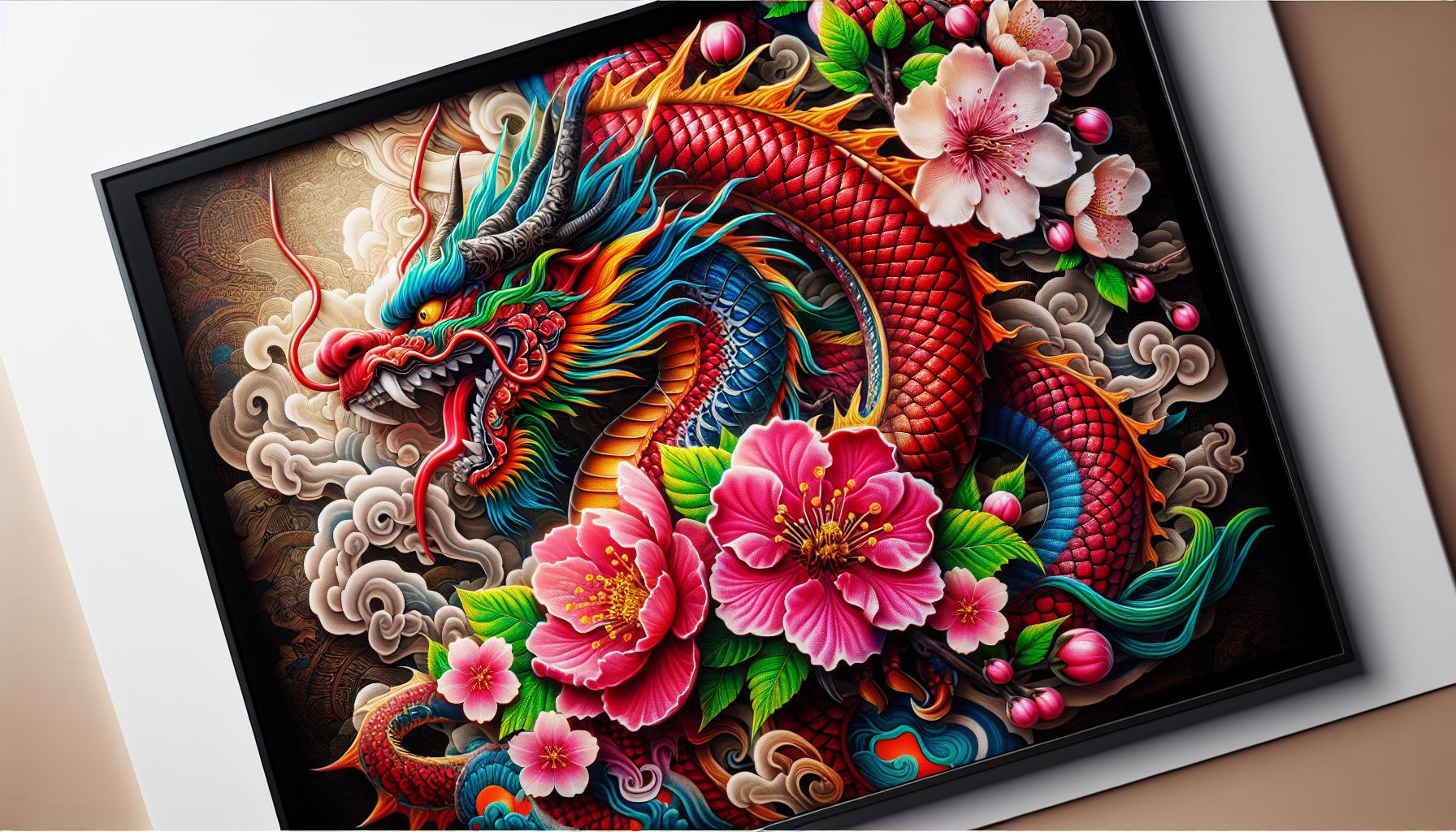
Korean tattoos carry deep cultural meanings and often showcase themes rooted in Korea’s rich heritage.
Nature-Inspired Motifs
- Flowers: We incorporate delicate flowers like the Korean Rose (Mugunghwa) and cherry blossoms into our tattoo designs. These blooms symbolize beauty, resilience, and growth. Cherry blossoms especially capture the fleeting beauty of life and the inevitability of change.
- Lotus: The lotus flower represents purity and spiritual enlightenment. Including lotus in our tattoos conveys a sense of spiritual depth and personal growth.
- Trees and Plants: Trees and various plants frequently appear in our designs, often intertwined with other motifs. This combination enhances the tattoo’s symbolic meaning and adds layers to its aesthetic appeal.
Mythological Figures
- Dragons: Dragons hold a prominent place in Korean tattoos, symbolizing strength, wisdom, and protection. Our dragon tattoos are designed with intricate details that highlight these powerful traits, making them a favorite choice for those seeking meaningful and impactful artwork.
Choosing the Right Korean Tattoo Symbol

Selecting the perfect Korean tattoo symbol involves balancing personal significance with visual appeal. Let’s explore how to make a choice that truly resonates with you.
Personal Meaning
Finding a symbol that reflects your personal journey is essential. We often connect deeply with designs like the dragon, which stands for strength and protection, or the phoenix, symbolizing rebirth and transformation. Also, the lotus flower represents purity and spiritual enlightenment, offering a meaningful narrative for your tattoo. Incorporating Hanja characters can convey personal values and beliefs, providing a unique touch that speaks to your individuality. By prioritizing symbols that align with your story, you ensure your tattoo holds lasting significance.
Aesthetic Appeal
Aesthetics play a crucial role in the tattoo selection process. We appreciate the intricate details of dragon tattoos, which showcase strength and wisdom through elaborate designs. Phoenix tattoos captivate with their ever-changing representation of renewal, often featuring vibrant colors and fluid lines. Lotus flowers add a touch of elegance and serenity with their delicate petals and graceful forms. Besides, integrating colors from Dancheong art, such as red for passion or blue for tranquility, can enhance the visual impact of your tattoo. By focusing on the visual elements that resonate with your style, you create a tattoo that is not only meaningful but also visually stunning.
Placement and Style of Korean Tattoos
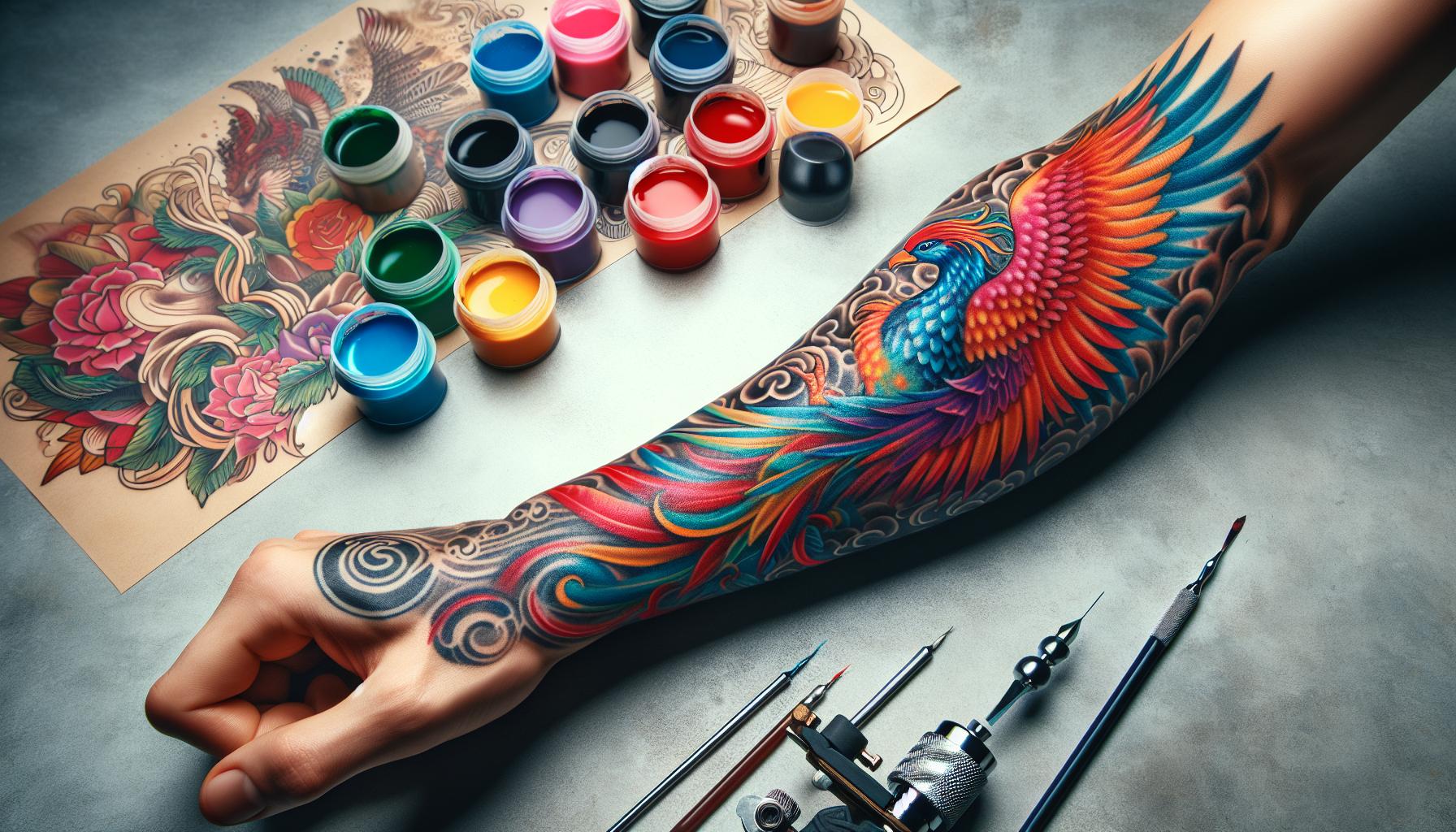
Choosing the right placement and style for your Korean tattoo ensures it not only looks great but also aligns with its symbolic meaning. Let’s explore the best locations and artistic techniques to bring your tattoo vision to life.
Optimal Tattoo Locations
Selecting the perfect spot for your Korean tattoo depends on both visibility and the symbol’s significance. We often see Korean tattoos prominently displayed on the arms, offering a great canvas for intricate designs like dragons and phoenixes. Shoulders are another favorite, providing ample space for larger symbols such as the lotus or dokkaebi. For those who prefer a more discreet approach, the back serves as an excellent area to feature meaningful imagery without immediate exposure. Also, the chest and legs are popular choices, allowing for balanced and harmonious placements that complement the body’s natural lines.
Artistic Styles and Techniques
Korean tattoos blend traditional motifs with modern artistic styles, creating unique and personalized pieces. We embrace techniques like watercolor effects to add vibrant colors and a fluid appearance to symbols like the phoenix and lotus. Geometric patterns are also favored, offering a contemporary twist to classic designs such as dragons and tigers. Minimalist styles highlight the elegance of simple lines and subtle details, perfect for those who appreciate understated beauty. Also, incorporating abstract elements can enhance the storytelling aspect of your tattoo, making each piece not just a symbol but a work of art. By combining these diverse techniques, we ensure your Korean tattoo stands out while honoring its rich cultural heritage.
Finding a Skilled Korean Tattoo Artist
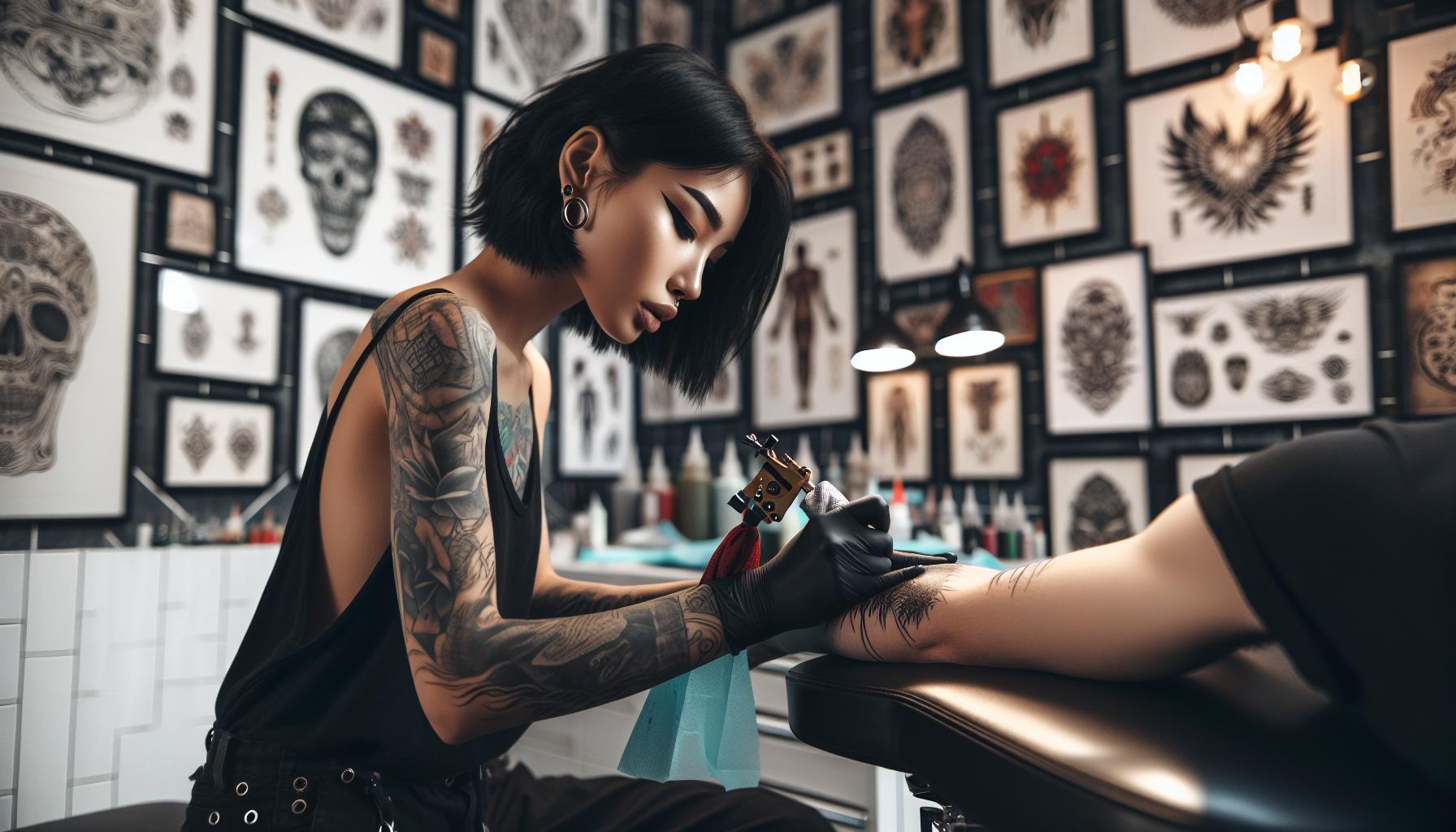
Choosing the right artist is crucial to bringing your Korean tattoo symbol to life. We focus on finding professionals who understand the depth and intricacies of these meaningful designs.
Researching Experienced Artists
Start by searching for tattoo artists who specialize in Korean designs. Look for those with extensive experience in traditional and modern Korean tattoo symbols. Visit their websites and social media profiles to assess their expertise. Attend local tattoo conventions to meet artists in person and view their work firsthand. Also, seek recommendations from friends or online communities passionate about Korean tattoo art. Prioritizing artists who are well-versed in Korean culture ensures your tattoo not only looks stunning but also holds genuine significance.
Evaluating Portfolio and Reviews
Carefully examine each artist’s portfolio to gauge their skill and style. Focus on the precision of linework, color usage, and attention to detail in their Korean symbol tattoos. Compare different artists to find someone whose work resonates with your vision. Reading client reviews provides insight into their professionalism and reliability. Pay attention to feedback on their ability to capture the essence of Korean motifs and their overall tattooing process. By thoroughly evaluating portfolios and reviews, we ensure that you select a talented artist who can deliver a high-quality, meaningful Korean tattoo.
Conclusion
Choosing a Korean tattoo symbol is a meaningful journey that blends tradition with personal expression. We celebrate the rich heritage these symbols carry and the modern twists that make each design unique. Whether it’s drawing strength from the tiger or embracing purity with the lotus, there’s a symbol that resonates with every individual story. Our appreciation for the artistry involved ensures that each tattoo not only looks stunning but also holds deep significance. By connecting with skilled artists who understand the cultural roots, we honor the legacy of Korean tattoo art while creating something truly personal. Embracing these symbols allows us to wear our stories proudly and beautifully on our skin.
Frequently Asked Questions
What are some popular Korean tattoo symbols?
Popular Korean tattoo symbols include the lotus flower, representing purity; the tiger, symbolizing strength and courage; dragons, denoting protection and power; phoenixes, signifying rebirth; and Hanja characters, which convey personal values. Additionally, the Mugunghwa rose represents perseverance, dokkaebi brings good luck, and norigae ornaments signify fortune. These symbols are often blended with modern design elements like geometric patterns, watercolor effects, and abstract art to create unique and meaningful tattoos.
Why are Korean tattoo symbols culturally significant?
Korean tattoo symbols carry deep meanings rooted in history and tradition. Each symbol, such as the dragon for strength or the lotus for purity, reflects aspects of Korean heritage and philosophy. These symbols not only enhance the aesthetic appeal of tattoos but also convey personal stories and values. By preserving their traditional meanings while adapting to modern styles, Korean tattoo symbols maintain their cultural significance and continue to influence contemporary tattoo art.
How can I choose the right Korean tattoo symbol for me?
Choosing the right Korean tattoo symbol involves balancing personal significance with aesthetic appeal. Consider symbols that reflect your personal journey, such as a dragon for strength, a phoenix for rebirth, or a lotus for purity. Evaluate the meanings behind each symbol and how they resonate with your values and experiences. Additionally, think about the design style—whether traditional, geometric, minimalist, or watercolor—to ensure the tattoo aligns with your visual preferences and personal style.
What are the best placements for Korean tattoos?
Optimal placements for Korean tattoos include the arms, shoulders, back, chest, and legs. Each location offers a unique canvas for intricate designs and allows the tattoo to complement the body’s natural lines. For example, the arm and shoulder are ideal for larger symbols like dragons or phoenixes, while the chest and back can accommodate detailed scenes or multiple symbols. Choosing the right placement enhances both the visual appeal and the symbolic meaning of the tattoo.
What styles are commonly used in Korean tattoo art?
Common styles in Korean tattoo art include traditional designs with intricate details, geometric patterns, minimalist approaches, watercolor effects, and abstract elements. Traditional styles emphasize the cultural heritage and historical meanings of symbols, while modern styles incorporate contemporary aesthetics. Artists often blend these styles or fuse Korean symbols with elements from other cultures to create personalized and unique tattoo designs that honor both tradition and modernity.
How do modern Korean tattoo designs differ from traditional ones?
Modern Korean tattoo designs adapt traditional symbols to contemporary tastes by incorporating elements like geometric patterns, minimalist lines, watercolor washes, and abstract forms. While traditional designs focus on detailed and culturally accurate representations, modern tattoos emphasize creativity and personal expression. This fusion allows for a broader range of styles, making Korean tattoos versatile and appealing to a wider audience while still preserving their original meanings.
How can I find a skilled Korean tattoo artist?
To find a skilled Korean tattoo artist, research artists who specialize in Korean designs by reviewing their portfolios for quality and style. Look for artists with experience in both traditional and modern Korean tattoo techniques. Read client reviews to ensure professionalism and reliability. Additionally, seek recommendations from friends or online communities. Prioritizing artists knowledgeable in Korean culture ensures your tattoo is both visually stunning and culturally authentic.
Are Korean tattoos suitable for beginners?
Yes, Korean tattoos can be suitable for beginners, especially when starting with simpler symbols like Hanja characters or minimalist designs. These tattoos allow for meaningful personal expression without requiring extensive detail. However, it’s essential to choose a reputable artist experienced in Korean tattoo styles to ensure the design is accurately represented. Beginners can gradually explore more intricate symbols and styles as they become more comfortable with tattoo art.
What does the lotus flower symbolize in Korean tattoos?
In Korean tattoos, the lotus flower symbolizes purity, spiritual enlightenment, and resilience. It represents personal growth and the ability to rise above challenges, much like the lotus blooms beautifully despite growing in muddy waters. This powerful symbol is popular for its aesthetic beauty and deep meaning, making it a meaningful choice for those seeking a tattoo that reflects their journey and inner strength.
Why should I choose a Korean tattoo symbol over others?
Choosing a Korean tattoo symbol offers a unique blend of rich cultural heritage and meaningful representations. These symbols are deeply rooted in Korean history and philosophy, providing tattoos with profound significance beyond their visual appeal. Additionally, Korean tattoo art incorporates both traditional and modern styles, allowing for personalized and versatile designs. Selecting a Korean symbol can celebrate cultural diversity and express personal values and stories in a distinctive and meaningful way.

